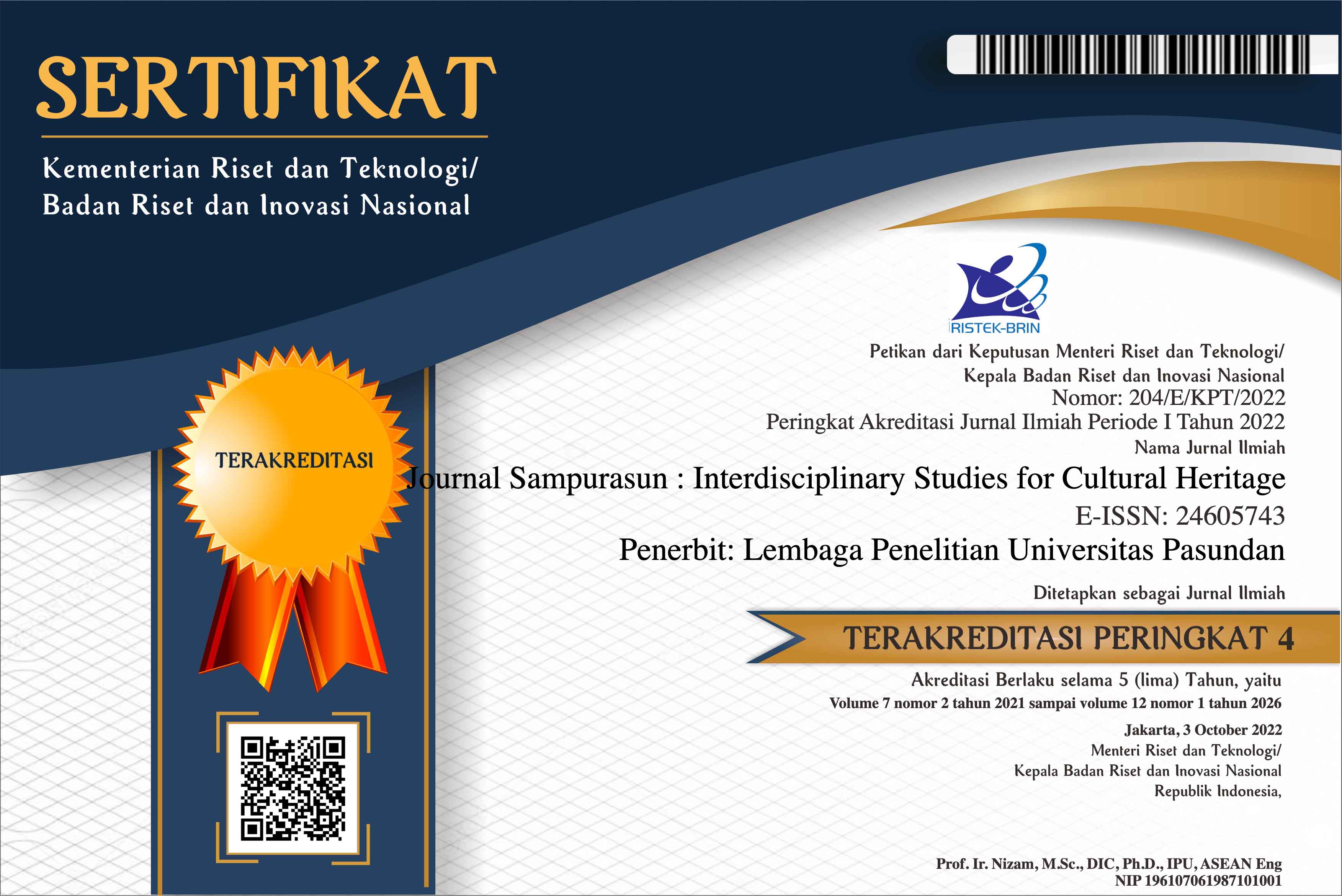ANALYSIS OF LANGUAGE COMPLIANCE IN THE FILM PEREMPUAN TANAH JAHANAM AS A REPRESENTATION OF JAVA CULTURE
DOI:
https://doi.org/10.23969/sampurasun.v8i2.6231Keywords:
Cultural representation, film, language politeness, pragmaticsAbstract
The Film is a tool to convey various messages to the general public through communication or dialogue. In communication, in
addition to paying attention to context, speakers must also have politeness in their language. Everyone's language politeness is
different, depending on the context or speech situation and social distance between individuals, especially if it is associated with
culture. Every culture has different standards of politeness. This study aims to examine language politeness as a representation of
Javanese culture in the film Perempuan Tanah Jahanam by Joko Anwar. The principle of politeness in the language is based on
Leech's theory which consists of (1) the maxim of wisdom, (2) the maxim of generosity, (3) the maxim of praise, (4) the maxim of
humility, (5) the maxim of compatibility, and (6) the maxim of sympathy. The method used in this research is the descriptive
qualitative method. The data collection technique in this research used the Listen Free Libat Cakap (SBLC) technique and the notetaking technique as further research techniques. Based on the results of data analysis, it can be concluded that there are
violations and fulfillment of politeness principles in this film's dialogue. Most show the fulfillment of the maxims of wisdom and
praise, while the maxims of humility and sympathy are often violated. The results of this study can represent politeness in
Javanese culture. it can be concluded that there are violations and fulfillment of politeness principles in this film's dialogue. Most
show the fulfillment of the maxims of wisdom and praise, while the maxims of humility and sympathy are often violated. The results of
this study can represent politeness in Javanese culture. it can be concluded that there are violations and fulfillment of politeness
principles in this film's dialogue. Most show the fulfillment of the maxims of wisdom and praise, while the maxims of humility and
sympathy are often violated. The results of this study can represent politeness in Javanese culture.
Downloads
References
Al Irsyad, M. I., & Indrawati, D. (2021). PRINSIP KERJA SAMA DAN KESANTUNAN
BERBAHASA DALAM WARUNG KOPI DAN CAFE DI SURABAYA. Sapala, 8(3), 1-25.
Hapsari, P. P., Harsono, H., Sawitri, S., & Basuki, S. H. (2022). ANALISIS KESANTUNAN
BERBAHASA DALAM NASKAH SÊRAT DONGENG ASMADAYA (KAJIAN
PRAGMATIK). Jurnal Review Pendidikan dan Pengajaran (JRPP), 5(1), 14-18.
Haryadi, H., Listini, L., Gunawan, G., Supriatini, S., & Yati, Y. (2021). KESANTUNAN
BERBAHASA DALAM PERCAKAPAN GURU DAN SISWA DALAM PROSES BELAJAR
MENGAJAR. Jurnal Bindo Sastra, 5(1), 33-44.
Hanafi, M. (2016). Kesantunan Berbahasa Dalam Perspektif Pragmatik. Cakrawala
Indonesia, 1(1), 1-10.
Nasution, A. I. (2022). Kajian Penerapan Dan Penyimpangan Prinsip Kesantunan
Berbahasa Pada Pesan Singkat Di Telegram: Kajian Pragmatik. Jurnal Ilmiah
Mahasiswa Pendidikan [JIMEDU], 2(2).
Prakoso, I. (2019). Kesantunan dan solidaritas dalam prespektif komunikasi lintas budaya
pada masyarakat Jawa dan Kei. SHAHIH: Journal of Islamicate Multidisciplinary, 4(2),
-137.
Prayitno, H. J. (2015). Tindak kesantunan berbahasa dalam dialektika pembelajaran
pragmatik: Berdaya, berorientasi, dan berstrategi kesantunan positif. Prosiding
Prasasti, 24-35.
Revameilawati, S., Setyadi, A., & Tiani, R. (2021). Kesantunan Berbahasa dalam Ceramah
Gus Miftah: Suatu Kajian Pragmatik. Endogami: Jurnal Ilmiah Kajian Antropologi, 5(1),
-115.
Rustono. (1999). Pokok-Pokok Pragmatik. Semarang: IKIP Semarang Press.
Santosa, M. P. S. A. (2020). Perbandingan Penyimpangan Prinsip Kesopanan Budaya India
dan Perancis Dalam Film The Hundred-Foot Journey. sarasvati, 2(1), 88-101.
Sapran, M. M. P., & Morelent, Y. (2019). PENERAPAN PRINSIP KESANTUNAN DAN
PRINSIP KERJASAMA PADA KOMPETENSI BERBAHASA INDONESIA SISWA KELAS
VIII SMP ISLAM TERPADU KHALID BIN WALID PASIRPENGARAIAN KABUPATEN
ROKAN HULU PROVINSI RIAU. Abstract of Undergraduate Research, Faculty of Post
Graduate, Bung Hatta University, 15(6).
Wahab, M. K. B. A., NorHashim, M. N. B., & Mohamad, W. A. B. W. (2021). Aspek
Kesantunan Dan Ketidaksantunan Berbahasa Dalam Kalangan Pelajar Bahasa Melayu:
Satu Kajian Perbandingan Dua Buah Negara: The Aspects of Politeness and
Impoliteness Speak in Malay Students: A Comparative Study of Two Countries. eJurnal Bahasa dan Linguistik (e-JBL), 3(2), 1-20.
Downloads
Published
Issue
Section
License
Copyright (c) 2022 Journal Sampurasun : Interdisciplinary Studies for Cultural Heritage

This work is licensed under a Creative Commons Attribution 4.0 International License.
Copyright Notice
Authors should not withdraw their submitted papers because the withdrawal wastes voluntary works devoted by an associate editor and reviewers. But, we accept the withdrawal of a submitted paper if authors have unavoidable reasons. In the event that a manuscript is to be withdrawn from submission to Sampurasun Journal, a letter must be sent to the editorial office requesting withdrawal by e-mail (sampurasunjournal@unpas.ac.id) with its scanned PDF file, before the notification of acceptance for publication.
The withdraw request letter must include the following information. Paper ID, Paper title, Authors names, Reason why the paper must be withdrawn, and Date and signatures of all the authors (or signature of the contact author).
If only the contact author signs the letter, he/she must obtain the agreement of the withdrawal from all the other authors and the letter must include the description that all the other authors agreed the withdrawal. The journal will not withdraw a manuscript from peer review until such a letter has been received. Authors must not assume their manuscript has been withdrawn until they have received appropriate notification from the editorial office. Withdrawal of a manuscript subsequent to acceptance for publication will only be granted in the most exceptional of circumstances.
After the paper is accepted for publication, the withdrawal is not permitted in principle. The authors must always pay the charge even if the withdrawal is permitted. Any request of withdrawal that does not follow the above procedure is treated as invalid. If illegal submission, e.g., plagiarized or duplicate submission, is found for a paper, the withdrawal of the paper will never be permitted and the authors will be punished based on the rule. It is not acceptable practice to withdraw a manuscript in the event of acceptance at another journal. This constitutes dual submission. The editorial office of the other journal will be notified of your actions. In such circumstances Sampurasun ISCH may chose to impose appropriate punitive action subject.
Withdrawal Penalty
Author is not allowed to withdraw submitted manuscripts, because the withdrawal is waste of valuable resources that editors and referees spent a great deal of time processing submitted manuscript, money and works invested by the publisher. If author still requests withdrawal of his/her manuscript when the manuscript is still in the peer-reviewing process, author will be punished with paying $200 per manuscript, as withdrawal penalty to the publisher. However, it is unethical to withdraw a submitted manuscript from one journal if accepted by another journal. The withdrawal of manuscript after the manuscript is accepted for publication, author will be punished by paying US$500 per manuscript. Withdrawal of manuscript is only allowed after withdrawal penalty has been fully paid to the Publisher. If author don't agree to pay the penalty, the author and his/her affiliation will be blacklisted for publication in this journal. Even, his/her previously published articles will be removed from our online system.


















